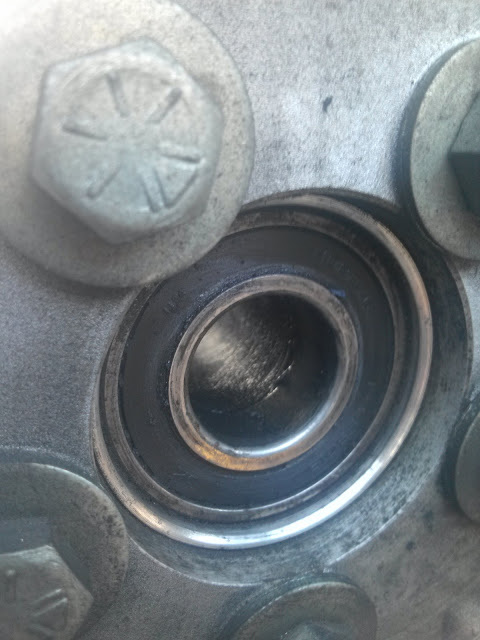Removing The Real Wheel From My Motorcycle
Last night I had a breakdown (scroll back to see that post), and today's work was figuring out what went wrong. Turns out the wheel bearings failed. What follows is a photo tour of the process of removing my rear wheel. I figure someone out there could use a visual walkthrough, and what's what the Internet is for.
The photos below are for a 2008 H-D Sportster 883, but probably aren't very different for other models and makes.
First, support the bike on a lift, in such a way that it won't be a problem when 40 pounds of weight comes off of the rear end later on. I have a cheap Harbor Freight lift, and also one car ramp to support the front wheel when it's off the ground.
 |
| The area of operations |
The wheel is held on by the axle, which acts as a very long bolt through the middle of the wheel. The axle is held in place by two things: a nut called the axle nut, and a metal clip called an E clip to keep the axle nut from moving even if it were to come loose.
So the second step is to pull off the E clip (a pair of pliers works, just don't bend it), then remove the axle nut. The axle nut was really tight and I couldn't torque it (good!) so I improvised a tool: the handle of my lift is a hollow tube, and it fits nicely over the shaft of my socket wrench.
 |
| The socket wrench, with a long enough handle -- the handle of my Harbor Freight lift. |
 |
| Success! The axle nut and the washer. |
Next up, loosen the drive belt. The tension of the belt, as well as the alignment of the rear wheel, is controlled by a pair of eye bolts and the nuts which tighten them. Simply remove the rubber caps, then loosen the belt tensioning nuts all the way. In a few minutes, your belt will be so loose you can remove it by hand.
 |
| Eventually there was a full inch of slack in the belt and it came off by hand. |
Lastly, remove the axle and the wheel will drop off by itself. For the most part, this is done by hammering the left-hand side of the axle, pushing it out the right-hand side. The manual says to use a rubber mallet, but in a pinch I used a hammer wrapped in a rag (this is not good for the rag). I also made a tool to let me hammer it a bit further through, using socket wrench parts.
 |
| A rubber mallet... yeah... |
Eventually, the axle comes out. I usually sit on the right-hand side and tug with a rag. The rear wheel will fall off, so have it supported. I have good boots and big feet, so it works for me to hold the wheel up with my foot as I remove the axle, and let it come down gently.
 |
| Right-hand side, the axle is coming out. |
 |
| Did I mention the spacer on the right-hand side? Don't lose it! |
And there you have it: no rear wheel, and open access to check out brake pads, a great opportunity to examine the wheel for cracks, to check out the tire, ...






